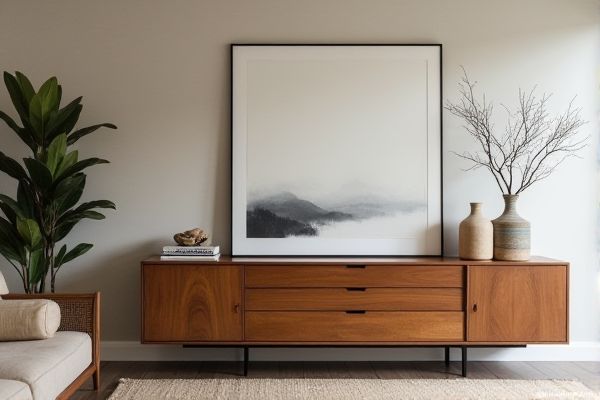
Gallery rails provide a vertical barrier on sideboards, preventing items from falling off while adding a decorative element, whereas flat top sideboards offer a sleek surface ideal for displaying larger pieces or serving food without obstruction. Explore the rest of the article to discover which style best suits your storage and aesthetic needs.
Table of Comparison
| Feature | Gallery Rail | Flat Top Sideboard |
|---|---|---|
| Design | Raised edge or rail around top surface | Flat, smooth top surface without edges |
| Functionality | Prevents items from falling off | Provides a clean surface for display or storage |
| Style | Traditional, vintage, or nautical | Modern, minimalist, or classic |
| Use Case | Ideal for displaying fragile or decorative items securely | Works well as a serving area or general storage surface |
| Maintenance | Requires dusting around rail edges | Easy to clean with flat surface |
| Material | Typically wood or metal with rail | Varies: wood, MDF, metal, or glass top |
Understanding Gallery Rail and Flat Top Sideboards
Gallery rail sideboards feature a raised lip or rail around the top edge designed to prevent items from falling off, making them ideal for secure display and storage. Flat top sideboards offer a smooth, uninterrupted surface that maximizes usable space for placing decorative objects, serving dishes, or other items. Choosing between gallery rail and flat top sideboards depends on the need for safety and containment versus a clean, versatile surface.
Key Design Differences
Gallery rails feature raised edges or a lip around the top surface to prevent items from falling off, enhancing both safety and display appeal. Flat top sideboards have a smooth, level surface without raised edges, offering a minimalist look suitable for larger decor or serving spaces. Your choice depends on whether you prioritize secure item display with a classic touch or a sleek, unobstructed tabletop for versatility.
Aesthetic Appeal: Gallery Rail vs Flat Top
Gallery rail sideboards feature raised edges or rails that enhance aesthetic appeal by adding a classic, ornate touch, often creating a framed display space ideal for decorative items. Flat top sideboards offer a sleek, minimalist look with clean lines, allowing versatility in styling and a more contemporary visual impression. Choosing between them depends on whether a traditional, detailed design or a modern, streamlined appearance best suits the room's decor.
Practical Uses and Functionality
Gallery rails offer practical storage for displaying decorative items and preventing objects from falling off shelves, making them ideal for areas where you want both visibility and security. Flat top sideboards provide a versatile surface for placing larger items such as serving dishes, lamps, or artwork, enhancing your room's functionality by combining storage with display. Your choice depends on whether your priority is safeguarding items with raised edges or maximizing flat surface space for diverse uses.
Storage Capabilities Compared
Gallery rail sideboards offer enhanced vertical storage with raised edges that prevent items from falling off, ideal for displaying decorative pieces securely. Flat top sideboards provide a larger uninterrupted surface area for placing wider or more sizeable objects, but lack the containment advantages of gallery rails. Storage capacity is typically influenced more by internal compartments and shelving than surface design, so choosing between the two depends on the balance between display needs and functional storage.
Room Placement and Style Compatibility
Gallery rails excel in entryways and hallways by providing versatile display options for artwork and photos, blending seamlessly with modern and eclectic interiors. Flat top sideboards suit dining rooms or living areas, offering a stable surface for decor and storage while complementing traditional, mid-century modern, or contemporary styles. Both pieces enhance spatial aesthetics but differ in function, with gallery rails emphasizing vertical display and sideboards prioritizing horizontal storage and surface use.
Materials and Craftsmanship
Gallery rails typically feature hardwoods like oak or walnut, showcasing ornate turned spindles that emphasize traditional craftsmanship and attention to fine detailing. Flat top sideboards use sleek, smooth surfaces crafted from materials such as maple, cherry, or engineered wood with veneer finishes, highlighting modern techniques and clean, minimalist design. Both styles demonstrate skilled woodworking, but gallery rails emphasize decorative artistry, while flat tops prioritize streamlined elegance and functional durability.
Maintenance and Durability
Gallery rail sideboards offer enhanced durability due to their raised edges that prevent items from falling, requiring minimal maintenance primarily focused on dusting and occasional polishing. Flat top sideboards, while easier to clean thanks to their smooth surfaces, may show wear more quickly, especially on exposed edges, demanding regular upkeep to maintain appearance. Your choice depends on balancing the need for sturdy, long-lasting design against straightforward cleaning routines.
Pros and Cons of Gallery Rail Sideboards
Gallery rail sideboards offer enhanced security with raised edges that prevent items from falling, making them ideal for displaying delicate or valuable objects. They can limit usable surface space and complicate cleaning compared to flat top sideboards, which provide a completely flat surface suitable for versatile use. While gallery rails add a decorative element and protect displayed items, flat tops provide easier access and more practical storage options.
Choosing the Right Sideboard for Your Space
Gallery rail sideboards offer a versatile display surface with raised edges, perfect for showcasing decorative items without the risk of them falling, making them ideal for spaces where aesthetics and functionality blend. Flat top sideboards provide a sleek, smooth surface suitable for placing larger items or serving trays, maximizing usable space while maintaining a minimalist look. When choosing the right sideboard for your space, consider whether you need extra security for delicate decor or prefer a seamless surface that complements your room's style.
 homyna.com
homyna.com